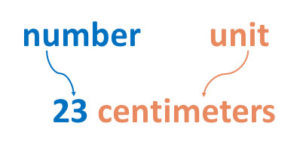Chemists perform both qualitative and quantitative analysis. A qualitative analysis is one that allows us to identify a substance–what is it? A quantitative analysis is one in which we determine the amount of a substance or even the amount of energy–how much do we have? Quantitative data consist of measurements. A measurement must include both a number and a unit in order for it to make any sense. If I state that a book measures 35, what does that mean? It could be 35 inches, 35 cm, 35 mm, etc. A unit must always be included with any measurement.

Today, most countries employ metric units to express measurements. In the United States, the metric system is used primarily in science and medicine. In the metric system, base units are used for length, mass, volume, time, temperature, energy, and the amount of substance. Later we will explain how to modify the base units with prefixes to express very large and small measurements. In 1960, another system called the International System of Units was adopted by a group of international scientists in order to keep standard units when reporting scientific measurements. These agreed upon units are called SI units and incorporate metric units (see Table). Many other units are derived from the basic metric units. For example, concentration, the quantity of a substance that is dissolved in a given volume, can have units of g/L or even mol/L. Density has units g/mL. You should know the metric base units and equivalent SI units shown in the following table.
In chemistry, we will not always measure quantities in just grams and liters. Sometimes, we will need to measure 103 grams of a substance or a volume of 10-3 liters. These units of measurement are based on the metric system, which uses either multiples of ten or fractions of ten. In the metric system, prefixes are used to express these differing magnitudes. For example, the amount 103 grams would be 1 kilogram, kg. The prefix kilo means 1,000. Using another prefix, the volume 10-3 liters would be expressed as 1 mL. The prefix milli means 1/1000 or 10-3. The common metric prefixes which most chemists use are shown in the following table. You must know the prefixes and how they are used to modify a base unit.
Aside from just memorizing these prefixes and the amounts they represent, let’s do some exercises to get a better feel for what they represent.
How many mL are in 5.68 L? First, find an equivalence. What do we know about mL and L? How can we relate them? Well, we know that there are 1000 mL in one liter or that 10-3 L = 1 mL. We can use either equivalence to convert 5.68 L to mL. From each equivalence, we can write two conversion factors. Working with 1000 mL = 1 L we can write the following two conversion factors.
To convert from liters to milliliters, the given (5.68 L) is multiplied by the conversion factor that cancels out the unit liters. In this case the first conversion factor is used to convert from L to mL.
Liters cancel out, and our answer is in mL. All we do to convert from mL to L is multiply by 1000. If we were asked to convert 5432 mL to L, we would divide by 1000 to give 5.432 L.
Exercises
Exercise 1. Convert 0.0043 mg to g.
Check Answer and/or View Solution
Exercise 2. How many ng are in 43.6 mg?
Check Answer and/or View Solution
Exercise 3. A piece of tubing is 0.566 cm long. How many μm does this correspond to? How many km?
Check Answer and/or View Solution
Go to Next Topic:Scientific Notation
Go Back To Previous Topic: Matter
Go Back to Study Guide List for General Chemistry 1
Go to Home Page
Go To Video List

